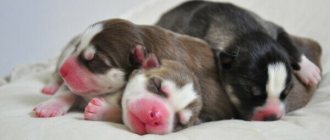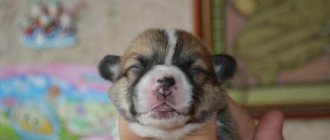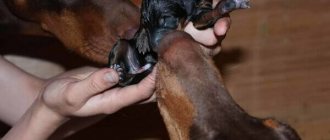The Welsh Corgi is a good-natured, sociable small dog.
The Welsh Corgi's muzzle is similar to a fox, height at the withers is 25 - 30 cm, weight is 10-15 kg.
Life expectancy is 12-15 years.
The second name for the Welsh Corgi is a short-legged shepherd dog, a strong, compact and quite strong dog - a boundless optimist and a wonderful companion.
What do newborn puppies look like in the photo and when do they open their eyes?
Newborn Welsh Corgi puppies are almost completely helpless; the only thing they can do is crawl in a circle and suck.
Babies are born blind, deaf, and dependent on an external source of heat.
Among other things, newborns are not able to defecate on their own; their mother helps them by licking their belly. Puppies' eyes open 10-15 days after birth.
Types of Welsh Corgi puppies
Welsh Corgi puppies, like adult dogs, are divided into 2 groups within the breed: Pembroke and Cardigan.
The latter are slightly larger in size and calmer, they are often less sociable than the Pembroke.
Another distinctive feature is the shape of the ears and tail. Cardigans have more rounded ears than Pembrokes, and their tail is longer and more fox-like.
As for Pombrokes, they are more active, cheerful, sociable and slightly smaller in size..
Who can get a dog of this breed?
If you want a Cardigan or Pembroke puppy, then you will most likely have a few more questions. For example, if you have small children, should you get a Welsh Corgi dog? These pets are good for children, because they are very kind. Of course, you need to immediately tell the kids that a puppy is not a toy and in the future it is advisable to ensure that the rules of behavior are followed.
If you work from morning to late evening, then you should not take a dog home. A whole day alone will have a bad effect on his mental and physical development. In general, it is best to take two Welsh Corgis, it will be very interesting for the two of them.
Do you already have pets at home? This is not a problem for both Cardigans and Pembrokes. Welsh Corgis have a friendly character and usually have no problems with other pets. Therefore, a dog of this breed will become your best friend and companion.
How does it develop day by day in the first month?
| Days | Development |
| 1-5 | The baby is completely helpless; during this period he does not know how to empty himself and needs additional heating, and also cannot hear or see. |
| 6-8 | The puppy experiences intense weight gain and the first reflexes begin to appear. |
| 8-9 | By this time, the weight of the newborn doubles. |
| 10-15 | The baby's eyes begin to open. In this case, the pupils react to light, but at the same time the puppy is still poorly oriented, since the retina of the eye is still in the process of development. |
| 16-18 | By this age, the Welsh Corgi puppy begins to activate its own thermoregulation. The baby gradually learns to cope without additional heating. |
| 19-21 | The puppy reacts to the sound and gradually begins to hear. |
| 22 | The first teeth erupt and the baby begins to try solid food. |
| 23-24 | The puppy already knows how to bite and chew. At the same time, his sucking reflex gradually fades away. During this period, the baby Welsh Corgi actively explores the world. |
| 25-30 | The baby begins a period of primary socialization, he already responds to a nickname, can leave the nest for a short time, actively moves and plays. |
Important Tips
A few important recommendations:
- The owner must understand that the dog eats food when it is hungry. If a pet runs happily, jumps, plays, but refuses to eat, you cannot force him to eat or persuade him, beg him, punish him for poor appetite;
- Train your dog to eat a portion of food quickly. A healthy animal eats food in five minutes. It is impossible for a pet to choose, chew for a long time or leave food and finish eating after half an hour;
- The owner must develop strong eating behavior in the dog. After putting the food in the bowl, offer it to your pet. If he sniffs and leaves, remove the cup. When the dog returns, he will realize that there is no food - he will remain hungry. Next time you experience the same behavior, repeat the steps. Sooner or later the dog will learn to eat the portion quickly;
- A puppy at 2-4 months should look well-fed - not thin or fat. After four months, the corgi will lose excess weight and begin to acquire the forms corresponding to an adult. Next, the dog should be in a dry condition. Excess weight is inappropriate here. This is important for the proper formation of the ligamentous, muscular and bone apparatus;
Proper, balanced nutrition is the key to the health of your four-legged friend!
How does it develop from 1 to 12 months?
Development of the Welsh Corgi from 1 to 12 months:
| Age (months) | Description | Size(cm) | Weight |
| 1 | The newborn period, in the first two weeks the puppy is absolutely helpless, blind and deaf. Starting from the third week, the baby’s eyes open, and a little later he begins to hear. By the end of the first month, the puppy switches to solid food and is actively interested in its surroundings. | 8-12 (newborn). 14-16 cm (by the end of the first month) | 300-600 g (newborn weight). 1.1-1.8 kg (puppy weight by the end of the first month). |
| 2 | The puppy's first baby teeth appear, he plays with toys, and is actively learning communication skills. | 16-20 | 2.1-2.9 kg |
| 3 | The baby Welsh Corgi goes through a period of socialization and continues to grow. The puppy continues to study the laws of the pack, dominant and weaker individuals begin to clearly appear. | 20-22 | 2.8-4.1 kg |
| 4 | By this age, the baby’s teeth change and their own immune system begins to form. | 22-24 | 4.1-5.4 kg |
| 5 — 6 | The puppy enters adolescence, restructuring occurs in his body, and hormonal levels change. It is during this period that teenage dogs begin their first sexual games. The dog's behavior during this period may change not for the better. | 20-28 | 5.6-8.5 kg |
| 7-9 | During this age period, Welsh Corgi bitches begin their first heats, they are active, excitable and already quite capable of fertilization. Males enter this stage a little later. | 28-30 | 7.2-8.5kg |
| 10 -12 | Completion of puberty. By this age, the dog has already reached puberty. Growth stops, the animal begins to gain strength. | 28-30 | 9-15 kg |
What should care be like?
To keep your pet healthy and live a long and happy life, follow these rules::
- Choose the right diet for your pet and feed it in accordance with age and weight standards. As for food, it must be of high quality, balanced and suitable for the Welsh Corgi breed.
- Take your baby for walks regularly, because Welsh Corgis need physical exercise. This is necessary for the proper development of joints and the entire musculoskeletal system.
- Inspect and clean your pet's eyes daily.
- The dog's nails need to be trimmed approximately once every 2-3 weeks.
- Bathe your dog at least once every 2-3 months. When bathing, use only social shampoos and conditioners designed for dogs.
- Be sure to give your pet vitamins and nutritional supplements containing beneficial substances.
- Give your dog anthelmintic medications once every 3 months.
- Once a week, the pet’s teeth are brushed with a special brush and toothpaste intended for dogs.
- Accustom your dog to a leash and collar from an early age, this will avoid many problems in the future.
- Try to find a good veterinarian.
- Take your dog to the veterinarian at least once a year.
- Give your pet a hygienic haircut once every six months.
Obesity in pets
Excess weight not only spoils the appearance, but also significantly worsens the health of your four-legged friend. Causes of obesity include metabolic diseases, genetic predisposition, a sedentary lifestyle and poor diet. Residential dogs are often affected.
Spayed female dogs often become predisposed to gaining excess weight. Disturbed hormonal levels provoke obesity
Up to a certain point, owners may be amused by the rounded shape of the Welsh Corgi, but excess weight is a colossal burden on the dog’s body. If you do not start the fight against extra pounds in a timely manner, obesity will set in - a real problem that leaves a negative imprint on the dog’s life and well-being.
Obesity contributes to the development of dangerous diseases that are often irreversible: diabetes mellitus, pathologies of the cardiovascular system. Don't forget about problems with the spine and joints that occur in overweight dogs. Therefore, you can’t risk your pet’s health; you need to start fighting excess kilograms in a timely manner!
How do you know if your body weight is normal? The most important criterion is the breed standard - the numbers are clearly written there. In addition to official indicators, you need to focus on your own animal, because... Every dog's body is different. Feel your pet's ribs - at a normal weight, they are easy to feel.
Also, in a non-obese dog, the ribs will protrude above the level of the abdomen when lying down. If you are overweight, it is difficult to see the respiratory movements of the chest.
Associated symptoms are shortness of breath, fatigue, and decreased performance.
The most important question: what to do? Bring your pet to the veterinarian. The specialist will conduct a thorough examination, prescribe, if necessary, examinations or tests, a special diet and advise the correct physical activity.
A suitable diet program is a key point in the fight against the worst enemy of a slim figure. The selected diet for an overweight dog is used to improve metabolism, lose weight, and strengthen the immune system. It is important to follow the veterinarian’s recommendations, follow a diet and prohibit family members from feeding the animal “delicacies”!
Physical activity is selected according to the individual characteristics of the corgi. Based on the condition and weight of the animal, the doctor prescribes an appropriate training program. It is important to increase the load gradually, listening to your own dog.
What to feed for the first 3 months?
A Welsh Corgi puppy can be fed both natural food and kibble. The main condition is not to mix them.
Products that must be included in the diet:
- Lean meat.
- Good quality porridge (buckwheat, oatmeal, rice).
- Eggs.
- Dairy products.
- Offal.
- Boiled fish.
- Vegetables (fresh or boiled).
You can give cheese or dog biscuits as a treat..
How to feed correctly and how often?
Proper nutrition means not only the quality of food, but also the regularity of feeding and the volume of portions.
Feeding frequency:
- A 2-month-old puppy should be fed 6 times a day in divided portions.
- At 3-5 months, the baby needs 5 meals a day.
- At 6 months of age, the dog can be switched to 3 meals a day.
- At 10 months of age, the puppy can eat 2 times a day.
70% of a Welsh Corgi's diet should consist of foods containing protein.
Menu for the week
Monday:
- Breakfast - cottage cheese, kefir or yogurt.
- Lunch - buckwheat porridge with boiled lung.
- Dinner – a piece of fish.
Tuesday:
- Breakfast - kefir or cottage cheese.
- Lunch – rice porridge with boiled turkey.
- Dinner - boiled beef with cabbage.
Wednesday:
- Breakfast – low-fat broth.
- Lunch – buckwheat porridge with liver.
- Dinner – oatmeal with fish.
Thursday:
- Breakfast: cottage cheese or kefir.
- Lunch – low-fat broth with a piece of meat.
- Dinner – rice porridge with liver.
Friday:
- Breakfast - low-fat chicken broth.
- Lunch - buckwheat with boiled heart.
- Dinner – kefir or cottage cheese.
Saturday:
- Breakfast – low-fat boiled fish.
- Lunch – buckwheat porridge and a piece of chicken.
- Dinner – oatmeal with stewed cabbage.
Sunday:
- Breakfast - yogurt, cottage cheese or kefir.
- Lunch – rice porridge with heart.
- Dinner – stewed beets with fish.
From an early age, accustom your pet to a limited amount of food, give exactly as much as necessary.
Vaccination schedule. Which ones are needed?
The first vaccinations for Welsh Corgi puppies can be given no earlier than 8-10 weeks of age.
Vaccination schedule:
- At 8-10 weeks, a comprehensive vaccination against leptospirosis, paragippus, distemper, parvovirus enteritis, hepatitis, adenovirus infection, and rabies is given.
- At 12-15 weeks, revaccination against the same ailments is given.
- At the age of 6-7 months, the procedure is repeated.
- At 12 months of age they do the same.
- Every year the dog is vaccinated against diseases such as distemper, rabies, parvovirus enteritis, hepatitis, leptospirosis, adenovirus infection. In this case, it is very advisable to use a vaccine from the same manufacturer.
Preparing for the arrival of a new family member
The compact size, charming appearance, and intelligence of these pets have provided them with well-deserved popularity. Scottish Shepherd Dogs are undemanding to living conditions and can thrive in a small apartment or a spacious country cottage. But before you bring a puppy into your home, you need to take care of ensuring comfort and safety for the new family member.
Puppies are inquisitive and will definitely explore a new space, using their claws and teeth. It will take some time for your pet to get used to the rules of canine hygiene. Therefore, before buying a puppy, you need to remove carpets, small objects, and electrical wires from the floor.
You need to purchase in advance everything you need to care for your dog:
- Litter.
- Bowls for food and water.
- Equipment for walking.
- Cosmetics for hygiene and care.
- Toys.
You don't have to buy a special lounger. A mattress with a removable cover made of durable material is suitable. For the dog, you need to choose a secluded corner where there is no heating device, drafts, or heavy traffic of people. The puppy must get used to its place from the first days of its stay in the house. It is advisable to get a playpen, a cage, and leave your pet in an enclosure when the owners are away. This will ensure the animal's safety.
How to train correctly and what should training be like?
Usually training begins with setting the correct intonation. A commanding and playful tone is the best option for a Welsh Corgi. After all, the puppy perceives training as a game.
The first stage is to accustom the baby to his nickname . Then you can start learning the command - “come to me”. To do this, say the nickname loudly and then the command. If your pet understands what is required of him, give him a treat.
The next command is “place”, pronounced in a stern voice and repeated as many times as necessary.
Another important command, “fu,” is given whenever the dog takes prohibited actions. After the command “fu” the treat is not given.
NOTE!
After the puppy has learned the basic commands, you can move on to active training.
The “fetch” command is perfectly accepted by the puppy and he carries it out with pleasure. It is usually practiced on the playground.
Whenever your dog has followed a command correctly, give it a treat. This way you can reinforce the skill.
How to distinguish a boy from a girl?
To determine the sex of a newborn Welsh Corgi puppy, simply examine it.
In a male dog, just below the navel, you will find a characteristic protrusion, which is covered with a tuft of hair; this is the genital organ hidden in the folds of the skin.
Males also have another tuft of hair between their hind legs; later the testicles will appear here.
In newborn girls, you will not find the characteristic protrusion and tuft of hair. Instead, she will have a tiny lump near her anus (under her tail) called a loop (genital slit).
Interesting Facts
- Pembroke's personality was described in one article as being a cross between a sea captain and a high school teacher. He enjoys being involved and in charge at the same time.
- In 2012, Orange Country hosted its first Corgi Beach Day. At first it was an exhibition of 15 corgis and their owners. Today, it has become a series of organized events throughout the country. The world record took place in Huntington, California. Information states that more than 1,200 spectators attended the event.
- A Pembroke named Rufus belonged to the editor-in-chief of Amazon.com. At the stage of site promotion, he came to work with the owner every day, walked around the halls, attended meetings and dozed off during them. Later, Rufus became the site's unofficial mascot.
- For over 70 years, corgis have been part of the British family. Queen Elizabeth was the proud owner of more than 30 corgis. The Pembroke Welsh Corgi is her favorite breed.
- The species has a recessive gene called the fluffy gene. It can be in both a bitch and a dog. If the parents have this gene, then the litter may produce one or more puppies with long hair.
- When the dog lays his body on the ground, from behind his butt looks like two chicken wings. This funny position of the dog is called sploot.
How to choose?
To avoid making a mistake when choosing a puppy, follow these rules::
- Buy puppies only from reputable nurseries or from reliable and trusted breeders.
- Pay attention to the conditions in which the parents of your future puppy live, since the conditions are the key to the health of the pet.
- Be sure to ask the breeder to show documents of the parents of the puppy you want to buy. Diplomas from exhibitions provide an almost 100% guarantee that your pet will have excellent appearance, good character and good health.
- Observe the baby's mother. Pay attention to her appearance, condition and behavior, because the dog takes 80% of its characteristics from its mother.
- Take a close look at the puppy itself. He should be active, cheerful and inquisitive, but at the same time not intrusive. It is also worth paying attention to the state of his health. Moderate fatness, good appetite, absence of discharge from the nose and eyes, a firm gait - these are signs of a healthy pet.
- The puppy must have documents: a puppy card and a veterinary passport. The card must indicate the organization that owns the nursery, its details and name.
- A Corgi puppy doesn't come cheap. A low price may indicate that he either has a breeding marriage or is sick with some kind of disease.
Optimal nutrition
At the stage of choosing a future pet, a person must clearly understand that he will have to feed it with high quality. Feed! And this concept does not hide feeding cutlets, sausages, sausages or other delights from the master’s table. The dog must receive proper, balanced nutrition.
A well-designed menu is a guarantee of the dog’s health and well-being, and also that you will not be a regular visitor to veterinary clinics.
Whether or not to prepare natural food for your pet daily is the owner’s decision. Not everyone has enough time to cook. Most people prefer ready-made commercial feed.
The owner’s main task is to choose high-quality food: premium or super-premium.
You can determine if food is suitable or not based on the following criteria:
- The pet looks great;
- Excellent wool;
- There are no stool abnormalities;
- Doesn't bother your ears;
- There are no skin diseases;
- No discharge from the eyes;
- Normal weight.
If the indicators coincide with reality, then you are incredibly lucky. They don’t look for good from good - don’t change the brand unless absolutely necessary.
When using dry food, it is necessary that the dog always has access to drinking water. Under the influence of liquid, the granules swell in the stomach, increasing in size. Actually, for the same reason, you should not leave a bag of pet food within reach.











